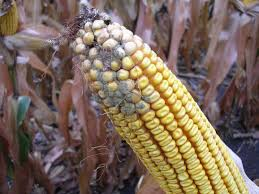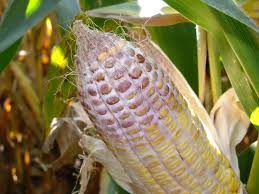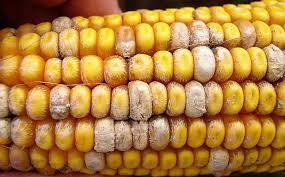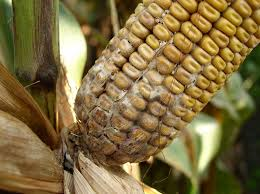Agronomy Update: Concerns with Ear Rot, Mycotoxins and Soybean Storage
BY DAIRYLAND SEED AGRONOMY TEAM
EAR ROT AND MYCOTOXIN UPDATE
A few weeks ago, the Dairyland Seed Agronomy Team discussed the importance of scouting for ear rots ahead of harvest. We knew this would be an issue around the Midwest, but didn’t anticipate it to strike quite as hard as it did in some areas. Be cautious with your feed sources!
The primary mycotoxins of interest to corn producers are aflatoxin, the fumonisins and vomitoxin. Mycotoxin contaminated grain can be poisonous to livestock and humans. Milk, eggs, meat and other animal derived foods for human consumption are also contaminated. These toxins can cause heart issues, nervous system issues and have been shown to cause cancer among other things, so these toxins should be taken seriously. The Food and Drug Administration has listed acceptable mycotoxin levels at www.FDA.gov and the National Corn Growers Association has provided a summary of acceptable aflatoxin and fumonisin at this link.
Diplodia, Gibberella, Fusarium and Aspergillis are the most common ear rots. All may produce Mycotoxins except for Diplodia. As we previously recommended, if ear rot is discovered:
- Identify the ear rot and adjust management accordingly (see the ID section).
- If the ear rot has been identified as a potential mycotoxin producer – collect a thorough and representative sample for testing.
- Harvest ear rot infested fields as soon as possible and dry to less than 15% moisture.
- Cool grain to less than 55 degrees. Some molds can continue to grow in storage.
- Adjust combine to minimize grain damage.
Common Ear Rot ID
Aspergillis:

- Mycotoxins may occur
- Drought, high temperatures and high humidity favors development
- Color may vary from green to yellow to a brownish powdery mold that forms between the kernels.
- Commonly occurs where insects or birds have damaged the kernels.
Gibberella:

- Mycotoxins can form
- Same pathogen that causes head scab in wheat and small grains
- Spores disperse from infected residue of corn, wheat and small grains.
- Infection begins developing on young silks
- Favors cool wet weather during and after pollination
- A pinkish fuzzy mold
Fusarium:

- Produces mycotoxins
- Survives on infected residue
- Warm dry weather favors development
- Disease enters plant through wounds caused be insects, hail and wind damage
- Can be white to pink in color, a starburst design may be seen the kernel.
Diplodia:

- Does not produce mycotoxins
- May cause ear rot, stalk rot and seedling blight
- Wet weather, moderate temperatures during silking through early dough stage favors development.
- Survives on infected corn residue from the previous years
- A tight husk, wet weather and upright ears predispose the ear to diplodia ear rot
- First appears at the base of the ear.
Please contact your Dairyland Seed agronomy team member if you need assistance in identifying any ear rot concerns.
SOYBEAN STORAGE
We are well into soybean harvest and, in some cases, soybean harvest is finished. With harvest closing, we start to focus on crop storage. If you are storing soybeans this fall and winter, there are just a few reminders we want to discuss.
Don’t forget, soybeans are denser and, of course, carry more oil than the more starchy, less oily corn kernel. A principle that applies to both commodities is the grain needs to be drier the longer it needs to be stored. Ideal storage moisture for soybeans is 13%, sound familiar? The same is true for corn. The safe storage moisture matches the grain grade ideal moisture.
One factor to remember is that soybeans are more fragile than corn and, therefore, high temperature drying can be a challenge. Iowa State University recommends 130 to 140 degrees for commodity beans and 100 to 110 degrees for seed beans. Air moves through soybeans more easily than corn so over-drying and damage can more readily occur. Once bins are full, aerate the bins and target a grain temperature of between 30 and 40 degrees F through the winter depending on your geography. For Summer storage it will be critical to keep the temperatures at the 40 to 60 degree F level.
The most critical lesson is that bins full of grain are NOT like those cookers on TV that tout “set it and forget it. Closely monitor the quality of your stored crops on a regular basis and be mindful of safety while doing so! For more detailed information please refer to the following bulletins:
https://extension.umn.edu/soybean/soybean-harvest-and-storage#fans-and-airflow-324361
https://crops.extension.iastate.edu/encyclopedia/soybean-storage-tips
 |
 |
 |
 |
 |
| Brian Weller Western Region 507.456.3034 |
Dan Ritter Central Region 219.863.0583 |
Branden Furseth Northern Region 608.513.4265 |
Rod King Eastern Region 574.596.6721 |
Terry Jones Eastern Region 419.630.3115 |
